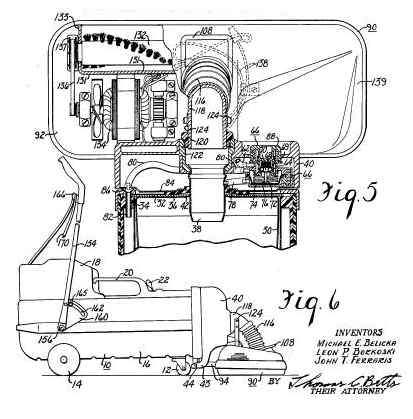| Electrolux's
Automatic Vacuum Cleaners A quick bit of info on your vacuum, how it works, and how to keep it working Vacuum cleaners are all about suction- or are they? Actually, suction doesn't actually exist. No really! It isn't a "real" force. Let me explain. In a vacuum cleaner, you have a motor attached to a fan that moves air through the machine: This is known as Air Flow. How much air moves through the machine depends on several factors- the size of the fan, the number and shape of the fan's blades and speed that the fan is turning are the factors most often considered. Obviously, another factor to consider is what may impede air flow- dirt, for the most part. But there's another, very important and obvious factor that is almost always overlooked. See if you can figure out what it is. Remember, there's no suction, just air flow. Which is how much air moves through the vacuum cleaner. See it? How much air flows through the machine... How... much... air... Ah-ha! Without air, there is no airflow, and thus no apparent suction. A vacuum cleaner in space won't do much, as there is nothing for it to move (except a few random atoms, perhaps). |  No pressure! Well, actually you want pressure, or your vacuum cleaner won't suck. |
Well, there's air everywhere on earth, at least above ground, right? Well, yes... But the amount of air isn't the same everywhere. The earth's atmosphere is nearly the same height all over the globe, if you measured out from the center of the earth. The atmosphere does bulge out at the equator a little bit more than at the poles, but since few people actually live at the poles, there is little need to consider this as a factor. So, while the height of the atmosphere is nearly the same, the land below is not. Your altitude affects air pressure. Other factors that also affect the weight of the atmosphere above you include Air Temperature and Moisture Content (as well as pollutants). Now, colder air is 'heavier' and warmer air is 'lighter' - but to balance things out, nature has a little trick: Moist air is heavier, and cold air can't hold as much moister as warm air, so the differences of air pressures in different climates has little effect on your vacuum cleaner- or at least what you will notice. Here are a couple of links to learn more about air pressure and factors that affect it: NOVA Online and NASA Kids-It's a Breeze. Instead we should consider only the altitude of the land you are on. Land at sea level has more air above it than, say, at the top of Mount Everest. Everything in the universe has weight, and air is no exception. At sea level, the air's weight, or pressure, is about 1000 Millibars (mb), but atop Mount Everest it is only about 330 mb (it's only ever been measured once so far, by the way). With less air to move, the apparent suction of a vacuum cleaner on Everest will be noticeably less than at sea level. Why? Well, back to air flow: The fan isn't actually sucking air through the vacuum cleaner. It's just trying to remove it from the machine. What's actually happening is that the atmosphere is pushing air into the machine to replace the air that the fan is pulling out. Anything in the way of the moving air will get blown along with the air flow, provided it is light enough to be moved by the force of the air flow. We understand the force of the air flow better if we call it suction. The amount of apparent 'suction' that a vacuum has can never be greater than the pressure of the air around it. But you can adjust the speed of the air flow. The same fan running at the same speed but with larger openings (both inlet and exhaust) moves the same amount of air as one with smaller openings, but at slower speeds. We know that objects (air, in this case) have weight (mass) and that when multiplied by speed (velocity), the force (pressure) that the object has increases as a result. Making the inlet smaller increases speed, and thus increases the apparent pressure, or "suction". We have all seen some kind of advertising gimmick where the vacuum cleaner is tested by lifting a bowling ball or some other heavy object. Sometimes they'll even show the stunt when the vacuum cleaner is full of dirt. In every case, some kind of attachment ensures a perfect seal on the object to be lifted. Any vacuum cleaner that isn't clogged so much as to cut off all air flow or one that has a leak in the inlet can perform this stunt. It is the attachment (a suction cup, typically) that gets pressed onto the object by the atmosphere: which is trying to equalize itself with the other side of the suction cup, and is doing all the work. The correct measure for the stunt should be how fast the vacuum cleaner creates the void inside the attachment. It is a balance between the air flow and speed of the air through the vacuum cleaner's attachments or nozzles that actually matters. A poorly designed vacuum system with unbalanced measurements will not be as effective as one that has been designed with properly balanced parts. |
 |